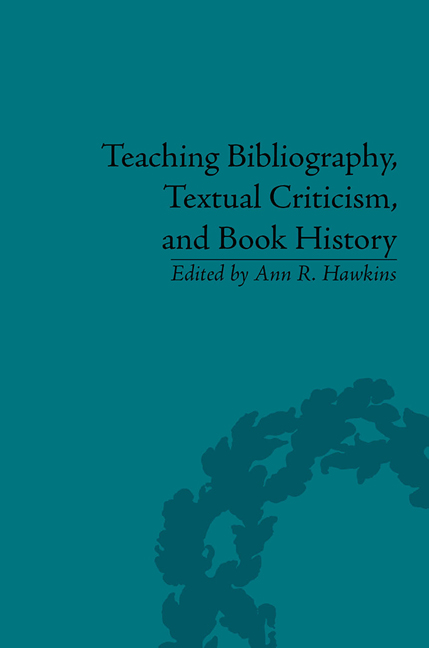Book contents
- Frontmatter
- Contents
- Notes on Contributors
- Foreword
- Introduction: Towards a pedagogy of Bibliography
- Part I Rationales
- Part II Creating and Using Resources
- Part III Methodologies
- Teaching ‘History of the Book’
- Teaching Bibliography and Research Methods
- Teaching Textual Criticism
- 20 How Things Work: Teaching the Technologies of Literature
- 21 ‘Not to Pick Bad from Bad, But By Bad Mend’: What Undergraduates Learn from Bad Editions
- 22 Book History and Reader-Response Theory: Teaching Shakespeare's Romeo and Juliet and King Lear
- 23 Textual Criticism: Students as Book Detectives and Scholarly Editors
- Afterword
- Part V Resources
- Index
21 - ‘Not to Pick Bad from Bad, But By Bad Mend’: What Undergraduates Learn from Bad Editions
from Teaching Textual Criticism
- Frontmatter
- Contents
- Notes on Contributors
- Foreword
- Introduction: Towards a pedagogy of Bibliography
- Part I Rationales
- Part II Creating and Using Resources
- Part III Methodologies
- Teaching ‘History of the Book’
- Teaching Bibliography and Research Methods
- Teaching Textual Criticism
- 20 How Things Work: Teaching the Technologies of Literature
- 21 ‘Not to Pick Bad from Bad, But By Bad Mend’: What Undergraduates Learn from Bad Editions
- 22 Book History and Reader-Response Theory: Teaching Shakespeare's Romeo and Juliet and King Lear
- 23 Textual Criticism: Students as Book Detectives and Scholarly Editors
- Afterword
- Part V Resources
- Index
Summary
Textual criticism and scholarly editing traditionally have been topics reserved to graduate school curriculums, probably because they have been seen as the domain of the college professor who prepares the texts and not of the broadly educated reader who consumes them. But we err if we do so, since such instruction nurtures kinds of analysis and communication useful beyond the professions of scholars and teachers, skills desired as much outside the academic world as inside it. Specifically, textual criticism encourages in students new attitudes toward the text. it helps address a quasi-fundamentalist approach too common in our students, that textbooks are unmediated, uncorrupted by human hands, singular texts possessing singular truths as intended by the authors.
Though textual criticism is valuable enough to deserve a course unto itself, it can be easily incorporated in small or large assignments as a part of every literature course. At one end of the spectrum, one might teach the ‘unediting’ that Leah Marcus and others call for, working backward through textual notes for a passage to reconstruct the witnesses and to interrogate editorial decisions. Such an assignment takes between ten and fifteen minutes of lecture to prepare the students, but in my experience the ensuing discussion practically runs itself. On one of the days devoted to Othello in a Shakespeare course, using The Riverside Shakespeare, I have students scan the textual notes to find the differences between Q1 (1622) and F1 (1623) in selected scenes, differences that are sometimes small but surprising.
- Type
- Chapter
- Information
- Teaching Bibliography, Textual Criticism, and Book History , pp. 161 - 166Publisher: Pickering & ChattoFirst published in: 2014



